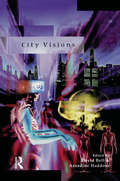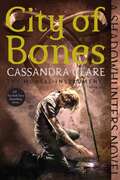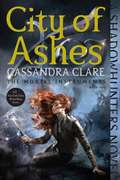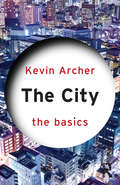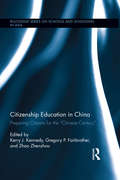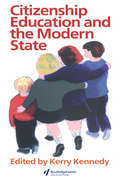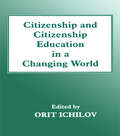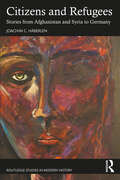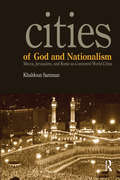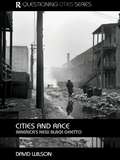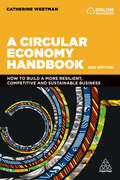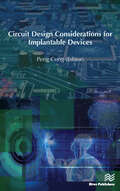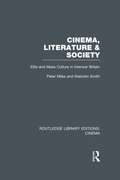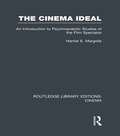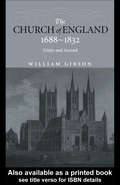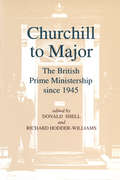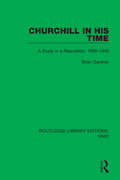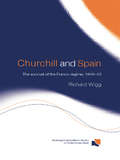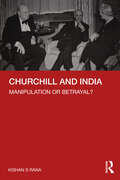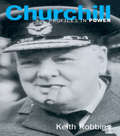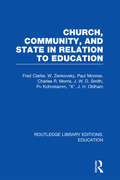Special Collections
Benetech’s Global Certified Accessible Titles
Description: Benetech’s GCA program is the first independent third-party EPUB certification to verify ebook accessibility. By creating content that is born accessible, publishers can meet the needs of all readers. Learn more: https://bornaccessible.benetech.org/
- Table View
- List View
Civic Education for Diverse Citizens in Global Times
by Beth C. Rubin and James M. GiarelliThis book explores four interrelated themes: rethinking civic education in light of the diversity of U.S. society; re-examining these notions in an increasingly interconnected global context; re-considering the ways that civic education is researched and practiced; and taking stock of where we are currently through use of an historical understanding of civic education. There is a gap between theory and practice in social studies education: while social studies researchers call for teachers to nurture skills of analysis, decision-making, and participatory citizenship, students in social studies classrooms are often found participating in passive tasks (e.g., quiz and test-taking, worksheet completion, listening to lectures) rather than engaging critically with the curriculum. Civic Education for Diverse Citizens in Global Times, directed at students, researchers and practitioners of social studies education, seeks to engage this divide by offering a collection of work that puts practice at the center of research and theory.
City Visions
by David Bell and Azzedine HaddourA collection of the latest work on the city, presenting contemporary theories, methods and perspectives in an accessible format for upper-level undergraduates and postgraduates in geography, cultural studies and sociology.
City of Bones
by Cassandra ClareDiscover this first installment of the internationally bestselling Mortal Instruments series and “prepare to be hooked” (Entertainment Weekly).When fifteen-year-old Clary Fray heads out to the Pandemonium Club in New York City, she hardly expects to witness a murder -- much less a murder committed by three teenagers covered with strange tattoos and brandishing bizarre weapons. Then the body disappears into thin air. It's hard to call the police when the murderers are invisible to everyone else and when there is nothing -- not even a smear of blood -- to show that a boy has died. Or was he a boy?This is Clary's first meeting with the Shadowhunters, warriors dedicated to ridding the earth of demons. It's also her first encounter with Jace, a Shadowhunter who looks a little like an angel and acts a lot like a jerk. Within twenty-four hours Clary is pulled into Jace's world with a vengeance, when her mother disappears and Clary herself is attacked by a demon. But why would demons be interested in ordinary mundanes like Clary and her mother? And how did Clary suddenly get the Sight? The Shadowhunters would like to know... Exotic and gritty, exhilarating and utterly gripping, Cassandra Clare's ferociously entertaining fantasy takes readers on a wild ride that they will never want to end.
City of Ashes
by Cassandra ClareIs love worth betraying everything? Plunge into the second adventure in the internationally bestselling Mortal Instruments series and "prepare to be hooked" (Entertainment Weekly).
Clary Fray just wishes that her life would go back to normal. But what's normal when you're a demon-slaying Shadowhunter, your mother is in a magically induced coma, and you can suddenly see Downworlders like werewolves, vampires, and faeries? If Clary left the world of the Shadowhunters behind, it would mean more time with her best friend, Simon, who's becoming more than a friend. But the Shadowhunting world isn't ready to let her go -- especially her handsome, infuriating, newfound brother, Jace. And Clary's only chance to help her mother is to track down rogue Shadowhunter Valentine, who is probably insane, certainly evil--and also her father.
To complicate matters, someone in New York City is murdering Downworlder children. Is Valentine behind the killings--and if he is, what is he trying to do? When the second of the Mortal Instruments, the Soul-Sword, is stolen, the terrifying Inquisitor arrives to investigate and zooms right in on Jace. How can Clary stop Valentine if Jace is willing to betray everything he believes in to help their father?
In this breathtaking sequel to City of Bones, Cassandra Clare lures her readers back into the dark grip of New York City's Downworld, where love is never safe and power becomes the deadliest temptation.
The City
by Kevin ArcherThe City: The Basics provides a brief yet compelling overview of the study of cities and city life. The book draws on a range of perspectives – economic, political, cultural, and environmental aspects are all considered – to provide a broad comparison of the evolution of cities in the rich Global North and the poorer Global South. Topics covered in the book include: a brief history of cities from ancient times to the post-modern present the differences between "global cities" in the North and "megacities" in the South the environmental impact of urban life and the idea of sustainable cities urban planning, urban politics and urban poverty. Featuring suggestions for further reading, recommended websites and a number of maps and illustrations, this is the ideal starting point for those interested in any aspect of cities or urban studies.
Citizenship in Nordic Welfare States
by Håkan Johansson and Bjørn HvindenThis book offers an innovative analysis of the ways in which the relationship between citizens and welfare states - social citizenship - becomes more dynamic and multifaceted as a result of Europeanization and individualization. Written by interdisciplinary contributors from politics, sociology, law and philosophy, it examines the transformation of social citizenship through a series of illuminating case studies, comparing Nordic countries and other European nations. Dealing with the following areas of national and European welfare policy, legislation and practice: activation – reforms linking income maintenance and employment promotion scope for participation of marginal groups in deliberation and decision-making impact of human rights legislation for welfare and legal protection against discrimination and social barriers to equal market participation coordination of social security systems to facilitate cross-border mobility in Europe pension reform – efforts to make pension systems sustainable. Citizenship in Nordic Welfare States will be of interest to students and researchers of social policy, comparative welfare, social law, political science, sociology and European studies.
Citizenship Education in China
by Kerry J. Kennedy and Gregory P. Fairbrother and Zhao ZhenzhouThere is a flourishing literature on citizenship education in China that is mostly unknown in the West. Liberal political theorists often assume that only in democracy should citizens be prepared for their future responsibilities, yet citizenship education in China has undergone a number of transformations as the political system has sought to cope with market reforms, globalization and pressures both externally and within the country for broader political reforms. Over the past decade, Chinese scholars have been struggling for official recognition of citizenship education as a key component of the school curriculum in these changing contexts. This book analyzes the citizenship education issues under discussion within China, and aims to provide a voice for its scholars at a time when China’s international role is becoming increasingly important.
Citizenship Education And The Modern State
by Kerry J. KennedyCitizenship education has recently re-emerged as an important issue, both in policy and in practice. As the nation state undergoes rapid transformation at the end of the 20th century, both Eastern and Western states have focused attention on using the school curriculum as a medium for sustaining cohesion and unity within society. But, as we approach the 21st century, is the possibility of a common citizenship a reality?; This book is designed to provide educators with access to ideas and information that will help them to understand current citizenship- education initiatives across a number of countries. It provides a theoretical rationale in which to consider those issues; illustrates how such issues are being worked out in practice in a number of countries; and provides assistance for policy makers, teacher educators and teachers who are responsible for making decisions about the context of citizenship education programmes for schools.
Citizenship Education and Migrant Youth in China
by Miao LiIn East Asian economies such as China, recent mass rural-urban migration has created a new urban underclass, as have their children. However, their inclusion in urban public schools is a surprisingly slow process, and youth identities in newly industrialized countries remain largely neglected. Faced with monetary and institutional barriers, the majority of migrant youth attend low-quality or underperforming migrant schools, without access to the free compulsory education enjoyed by their urban counterparts. As a result, China’s citizen-building scheme and the sustainability of its labor-intensive economy have greatly impacted global economic restructuring. Using thorough ethnographic research, this volume examines the consequences of urban schooling and citizenship education through which school and social processes contribute to the production of unequal class relations. It explores the nexus of citizenship education and identity-forming practices of poor migrant youth in an attempt to foresee the new class formation in Chinese society. This volume opens up the "black box" of citizenship education in China and examines the effect of school and societal forces on social mobility and life trajectories.
Citizenship and Citizenship Education in a Changing World
by Orit IchilovPolitical, economic, technological and cultural changes have taken place all over the globe, changes which have transformed the meanings of citizenship and citizenship education. This volume represents an effort to analyze the implications of these changes.
Citizens and Refugees
by Joachim C. HäberlenFollowing the stories of two dozen refugees from Syria and Afghanistan in 2015, Citizens and Refugees argues that we need to include the histories of these countries, notably the Syrian Revolution, into narratives of the refugee crisis. The book thus challenges a framing of the crisis that usually begins only with the moment of people fleeing. The stories it tells show refugees as citizens with a political voice engaged in struggles for participation and democracy, rather than as people in need of rescuing and integrating into new societies. It equally examines the much-celebrated German welcoming culture of 2015, arguing that it silenced political voices of those fleeing to Germany. Based on personal stories and the author’s intimate knowledge of the German welcoming culture, Citizens and Refugees intervenes into political debates about the viability of democracy. Overall, the importance of this volume stems from its suggestion that we would do well to listen to the voice of those coming to Europe as refugees. Based on both personal stories and historical analysis, Citizens and Refugees is the ideal resource for upper-level undergraduates, postgraduates, and scholars interested in migration studies and the history of Europe and the Middle East.
Cities of God and Nationalism
by Khaldoun Samman"A tour-de-force in different fields of knowledge. It takes world-city and world-history literatures to a higher level of depth and understanding. It is difficult to imagine a more pioneering, in-depth study of world cities." Ramon Grosfoguel, Professor, Department of Ethnic Studies, University of California, Berkeley "A remarkable and original discussion of three great sacred cities across time, and their transformation by nationalism in the modern world." Immanuel Wallerstein, Yale University Far from spawning an age of tolerance, modernity has created the social basis of division and exclusion. This book elaborates this provocative claim as it explores the rich but divided histories of three cities located at the crossroads of Islam, Christianity, and Judaism. Many observers presume that violence is built into these sacred cities because their citizens cling to religious or cultural ideals of some archaic age; only when this history is overcome can citizens enter a new age of brotherhood. Samman persuades us to refocus our attention on modernity, which has instilled troubling dilemmas from the outside. He shows how these sacred places long ago entered the modern world where global political and economic forces exacerbate nationalism and regional divisions. If we are to resolve deep conflicts we must re-imagine the institutional basis on which modernity, rather than religion, is built.
Cities and Race
by David WilsonThis fascinating book examines the 1990s rise of a new black ghetto in rust belt America, 'the global ghetto'. It uses the emergent perspective of 'racial economy' to delineate a fundamental proposition; historically neglected and marginalized black ghettos, in a 1990s era of societal boom and bust, have become more impoverished, more stigmatized, and functionally ambiguous as areas. As these ghettos grow in size and become more stigmatized entities in contemporary society, our understanding of them in relation to evolving cities and society has not kept pace. This book looks to the heart of this misunderstanding, to find out how race and political economy in cities dynamically connect in new ways ('racial economy') to deepen deprivation in these areas. This book is an essential read for students of geography, urban studies and sociology.
Cities
by John LorincA thought-provoking look at the demands and expectations we place on our growing cities in the twenty-first century. An excellent introduction to the subject for young adults. Today, more people live in cities than in rural areas. The search for better housing, transit, economic opportunity, and security within neighbourhoods forces today's city-dwellers -- in both the developed world and in megacities in Asia, Africa, and Latin America -- to confront what it means to live in our urban world. In this book, cities specialist John Lorinc considers the enormous implications of the mass migration away from rural regions, and predicts that solutions will emerge from neighbourhoods and dynamic networks linking communities to governments and the broader urban world. "[The Groundwork Guides] are excellent books, mandatory for school libraries and the increasing body of young people prepared to take ownership of the situations and problems previous generations have left them." -- Globe and Mail Correlates to the Common Core State Standards in English Language Arts: CCSS.ELA-LITERACY.RI.6.1 Cite textual evidence to support analysis of what the text says explicitly as well as inferences drawn from the text. CCSS.ELA-LITERACY.RI.6.2 Determine a central idea of a text and how it is conveyed through particular details; provide a summary of the text distinct from personal opinions or judgments. CCSS.ELA-LITERACY.RI.6.3 Analyze in detail how a key individual, event, or idea is introduced, illustrated, and elaborated in a text (e.g., through examples or anecdotes). CCSS.ELA-LITERACY.RI.6.4 Determine the meaning of words and phrases as they are used in a text, including figurative, connotative, and technical meanings. CCSS.ELA-LITERACY.RI.6.6 Determine an author's point of view or purpose in a text and explain how it is conveyed in the text.
A Circular Economy Handbook
by Catherine WeetmanWINNER: 2018 Les Plumes des Achats & Supply Chain - The Committee Special Prize As we learn more about the climate and biodiversity crisis, it is clear that how we make and consume things is a major part of the problem. Extraction and processing of materials, fuels and food makes up about half of global greenhouse gas emissions and over 90% of biodiversity loss and water stress. Many modern businesses deplete resources, destroy ecosystems and dump waste and pollution at every stage - harming human health along the way. Governments, businesses and think-tanks see the circular economy as the way forward. Now in its second edition, A Circular Economy Handbook is a guided tour through the concepts and the practicalities. A unique framework systematically explores the range of circular interventions, including product and supply chain design, material choice and supporting business models. How does it really work for business? What circular approaches are emerging in food, fashion, consumer technology, packaging and other sectors? How do these reduce risk, improve resilience and build profitable, future-fit organizations? With over 300 real examples from around the world, this is a must-read for businesses, students and policymakers. This new edition has been extensively updated to include the latest trends, thinking, research and solutions, with a new chapter on packaging and 30 new company snapshots.
Circuit Design Considerations for Implantable Devices
by Peng CongImplantable devices are a unique area for circuit designers. A comprehensive understanding of design trade-offs at the system level is important to ensure device success. Circuit Design Considerations for Implantable Devices provides knowledge to CMOS circuit designers with limited biomedical background to understand design challenges and trade-offs for implantable devices, especially neural interfacing.Technical topics discussed in the book include: Neural interface Neural sensing amplifiers Electrical stimulation Embedded Signal Analysis Wireless Power Transmission to mm-Sized Free-Floating Distributed Implants Next Generation Neural Interface Electronics
Cinema, Literature & Society
by Malcolm Smith and Peter MilesDuring the interwar period cinema and literature seemed to be at odds with each other, part of the continuing struggle between mass and elite culture which so worried writers such as Aldous Huxley, T.S. Eliot and the Leavises. And this cultural divide appeared to be sharp evidence of a deeper struggle for control of the nation’s consciousness, not only between dominant and oppositional elements within Britain, but between British and American vales as well. On the one hand, films like Sing As We Go, Proud Valley, and The Stars Look Down consolidated the assumptions about the existence of a national rather than separate class identities. On the other hand, working-class literature such as Love on the Dole articulated working-class experience in a manner intended to bridge the gap between the ‘Two Englands’. This book, originally published in 1987, examines how two of the most significant cultural forms in Britain contributed indirectly to the stability of Britain in the interwar crisis, helping to construct a new class alliance. A major element in the investigation is an analysis of the mechanics of the development of a national cultural identity, alongside separate working-class culture, the development of the lower-middle class and the implications of the intrusion of Hollywood culture. The treatment throughout is thematic rather than text-oriented – works of Graham Greene, George Orwell, Bert Coombes, Evelyn Waugh, the British Documentary Film Movement and Michael Balcon are included in the wide range of material covered.
The Cinema Ideal
by Harriet E. MargolisThis study explores the model derived from Freudian and Lacanian psychoanalysis, via Marxism and semiotics, of looking at film. It retraces the steps of film theory from ideological criticism of the late ‘60s to spectator studies in 1988 when the book was originally published. Psychoanalysis enables a discussion of the cinema’s role as a social and political force and this book enters a discourse of the politics of representation. Reconstructing discussion of basic issues, the book addresses our instincts and defences in reacting to cinema, the similarity between mental processes and cinematic technique, narrative techniques and the ‘cinematic apparatus’. Importantly, the book concerns itself with the concept of ideology and how the filmviewing experience engages the spectator in a complex net of stimuli presenting representations of an ideal world and the effect of this within film studies.
The Church of England 1688-1832
by William Gibson and Dr William GibsonA wide ranging new history of a key period in the history of the church in England, from the 'Glorious Revolution' of 1688-89 to the Great Reform Act of 1832. This was a tumultuous time for both church and state, when the relationship between religion and politics was at its most fraught.This book presents evidence of the widespread Anglican commitment to harmony between those of differing religious views and suggests that High and Low Churchmanship was less divergent than usually assumed.
Churchill to Major
by Philip Giddings and Martin Burch and R.L. BorthwickThis text summarizes the research on, and experiences of, democratic legislatures around the world. It focuses on what legislatures are and what they do - as both consequence of and contributor to democratic self-government.
Churchill in his Time
by Brian GardnerThis book, first published in 1968, analyses Winston Churchill’s war years using a wide range of little-consulted sources to give us a full and round picture of a prime minister beloved by many but disliked by others. Contemporary accounts and opinions bring us close to the reality of the man, and in doing so give us also a picture of a nation struggling with total war.
Churchill and Spain
by Richard WiggThis thoroughly researched, highly perceptive and utterly gripping study deals with an important aspect of Spanish and British history - Churchill's policy of appeasement toward the Franco regime in Spain. Wigg demonstrates that the tolerance shown toward Spain's wartime trading permitted the rebuilding of Spanish gold reserves which helped Franco survive his (and Spain's) international ostracism between 1945 and 1950.This important book will interest scholars with an interest in contemporary European political history as well as those with a general interest in Spanish history.
Churchill and India
by Kishan S RanaChurchill and India. It is a story where much is known but much remains concealed. A brilliant orator and a powerful leader, Winston Churchill stood against the tide of history. But how does postcolonial history view him? This book studies the extraordinary connection he had with India. Beginning with the early years of his career in India when he spent 22 months between 1896 and 1899 as a subaltern with the 4th Hussars, it traces his rise as a politician, his years as the Prime Minister of Great Britain during the Second World War, his profound distrust of the Indian Independence Movement, and his machinations in preserving the British Empire’s rule over India. Churchill’s failure to understand India and decolonization, and manipulation of events on the subcontinent add a different dimension to the man. His pervasive yet hidden shadow over the Indian subcontinent and his often-veiled role in the actions that led to Partition in 1947 are at the center of this study. Rich in archival sources, this book provides a fresh and holistic perspective on the final phase of the British Empire. It will be an indispensable resource to students and researchers of colonial history, imperialism, modern history, international history, Partition of India, and South Asian studies. It will also appeal to general readers interested in the history of Britain’s endgame in India.
Churchill
by Keith RobbinsKeith Robbins provides an excellent introduction to Winston Churchill's dramatic rise to power and traces the unpredictable way his career moved between triumph and tragedy. Providing a vivid picture of the political landscapes through which he moved, it outlines his career and uncovers what made possible Churchill's leading role in national and world affairs.
Church, Community and State in Relation to Education
by Fred ClarkeThis volume was originally prepared for the World Conference on Church, Community and State held in Oxford in 1937. Its aim was to understand the nature of the vital conflict between the Christian faith and the secular tendencies of the early twentieth century, particularly in relation to education. The book also analyses the responsibilities of the Church in this struggle.

